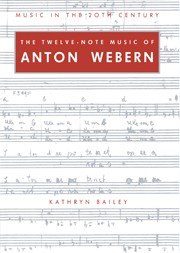Book contents
- Frontmatter
- Contents
- Acknowledgements
- Conventions in the text
- Introduction
- PART I Row and canon
- PART II The instrumental music
- PART III The music with voices
- Introduction to Part III
- 8 Das Augenlicht
- 9 Cantata I
- 10 Cantata II
- Conclusion
- Appendices
- Notes
- Glossary
- Chronological worklist
- Select bibliography
- Index
- Frontmatter
- Contents
- Acknowledgements
- Conventions in the text
- Introduction
- PART I Row and canon
- PART II The instrumental music
- PART III The music with voices
- Introduction to Part III
- 8 Das Augenlicht
- 9 Cantata I
- 10 Cantata II
- Conclusion
- Appendices
- Notes
- Glossary
- Chronological worklist
- Select bibliography
- Index
Summary
The text is expressed very directly in the Op. 29 Cantata. The shape and structure of the instrumental music are suggested by the poems; in fact, the orchestra seems to express the sense of the text in a more intrinsic way than the voices, whose responses are nearer to the surface. In the first movement orchestra and chorus alternate, and while the orchestral music displays considerable rhythmic and structural complexity the choral music does not, focusing instead on the manifold possibilities offered by invariance, a property which results, perceptually at least, in increased simplicity. In the second movement, the orchestra responds to the text through a pointillistic distribution of very short motives, at the same time engaging in canonic imitation of a mobile nature. The solo soprano, whose part could hardly have been deployed in a pointillistic fashion, remains outside this structure, providing a model for the canon that proceeds around her. The chorus and orchestra join forces only in the third movement. Here, although the structure is complex, the voices seem almost to be an afterthought: the movement is complete without them. The material is exposed by instruments alone, and when the voices join later they only reinforce instrumental parts. One cannot speak, therefore, of the structure or nature of the voice parts in this movement, because the chorus does not exist as an independent entity.
‘Zündender Lichtblitz des Lebens’
The text of the first movement is presented by unaccompanied chorus in twenty–two bars at the centre, framed by thirteen bars at the beginning and twelve at the end for orchestra alone. As a result, the instrumental music that accounts for more than half of this movement never coincides with the text.
- Type
- Chapter
- Information
- The Twelve-Note Music of Anton WebernOld Forms in a New Language, pp. 272 - 302Publisher: Cambridge University PressPrint publication year: 1991

